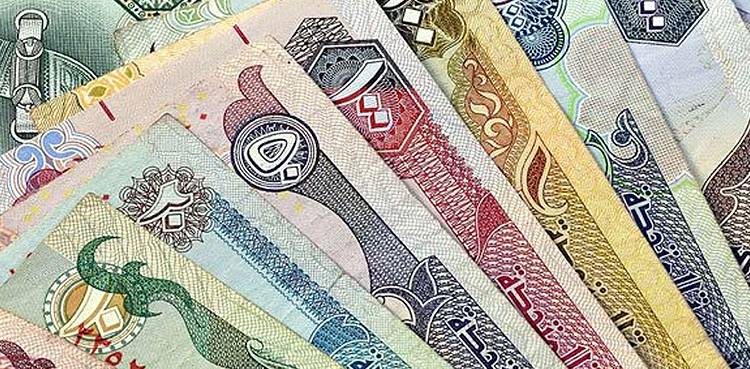Karachi, May 14, 2025 – The UAE Dirham (AED) exchange rate remained steady against the Pakistani Rupee (PKR) today at 76.71 PKR in the open market, as per the latest currency exchange market reports.
This steadiness is a consequence of a comparatively calm period in the AED-PKR exchange rate, driven by steady remittance inflows and stable economic conditions in Pakistan and the UAE.
Process of Valuation for AED-PKR Exchange Rate
The value of UAE Dirham relative to the Pakistani Rupee is influenced by the forces of the market and actions of central banks. The AED is pegged to the US Dollar at approximately 3.67 AED per 1 USD, a policy that has been maintained by the Central Bank of the UAE since 1997. The peg ties the Dirham in foreign exchange, causing its value to fluctuate with that of the US Dollar, backed by the UAE’s strong oil-based economy and diversified investments.
1 UAE DIRHAM = 76.71 PAKISTANI RUPEES
In contrast, the PKR has a managed floating regime based on demand and supply in the foreign exchange market, while the State Bank of Pakistan at times intervenes to stabilize currency fluctuations. Foreign exchange reserves, trade balance, inflation rate, and remittance inflows are major determinants of the value of the PKR, and the UAE contributed $3.1 billion remittances in February 2025 alone.
The AED-PKR exchange rate is set on a daily basis by interbank market rates and open market operations. The banks and exchange houses set the buying and selling rates, which are now a buying rate of 76.71 PKR and a selling rate of approximately 77.25 PKR, indicating the sellers a slight premium. Exchange rates are updated periodically, usually at around 8:00 AM Pakistan Standard Time, and may fluctuate during the day based on market forces.
Effect of Stability
The stability of the AED at 76.71 PKR has far-reaching effects on Pakistan and its expatriates in the UAE. For over two million Pakistani expatriates working in the UAE, stability in exchange rates translates into security of value of remittances, which enables them to invest and support their families back in Pakistan. The stable rate also benefits firms engaged in trade between the two nations, particularly those in the food, textile, and construction materials sectors, by mitigating currency risk.
For Pakistan’s economy, stability of the AED-PKR exchange rate enhances remittance inflows, which form an important part of the country’s foreign exchange reserves. According to analysts, this stability results from balanced trade operations, strong foreign exchange reserves, and negligible speculative pressure in the currency market. The UAE remains among Pakistan’s best financial conduits, and remittances have a significant bearing on maintaining the Pakistani Rupee in line with other currencies. However, the UAE’s managed float system makes it vulnerable to internal factors such as inflation and trade deficits. Experts in currency advise that, even though the AED-PKR rate is healthy now, traders and investors should remain vigilant concerning global oil prices and geopolitical issues that can impact the US Dollar and consequently the Dirham value.
Introduction to AED and PKR
The UAE Dirham is the official currency of the United Arab Emirates introduced in 1973 to replace the Qatar and Dubai Riyal. It is remunerated in Dirhams by the UAE Central Bank and is divided into 100 fils, which are symbolized by “د.إ” or “Dhs.” The fixed rate of exchange of Dirham with respect to the US Dollar stabilizes it, supported by the UAE’s oil-based economy, prudent fiscal policy, and status as an international trade hub. It is more commonly accepted in all the seven emirates, Dubai and Abu Dhabi included, and is more commonly accepted in major tourist spots all over the region.
The Pakistan Rupee (PKR) was introduced when Pakistan became an independent nation in 1947 as a standard currency of the nation, further subdivided into 100 paise. It is symbolized by the symbol “₨” or “Rs” and is issued by the State Bank of Pakistan. The PKR has a controlled float regime for the exchange rate, so it is more vulnerable to domestic economic factors like inflation, trade deficits, and foreign exchange reserves. The currency is highly significant to the Pakistani economy, with expatriate remittances from the UAE playing a key role in determining its stability. At present, UAE Dirham’s fixed exchange rate of 76.55 PKR indicates Pakistan and UAE’s bilateral economic engagement in the forms of remittances and trade. Though the UAE Dirham has a lucky chance of peg with the US Dollar, PKR’s worth stands decided on Pakistan’s total economic fundamentals. The stable exchange rate provides a sense of security to expatriates and companies, but caution is needed since both external and internal factors may influence future trends.


Leave a Comment